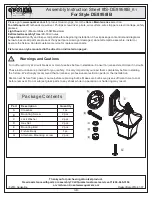
Synchronous triggering during Stand-Alone operation
35
Synchronous
triggering during
Stand-Alone
operation
Note
This chapter details the rules that are used in Stand-Alone
synchronous triggering. It is not necessary to read this chapter
unless you require help with problem diagnosis or unless you
otherwise need a detailed understanding of the algorithm used
for synchronous triggering.
The rules are as follows:
1 Every fixture can have up to 20 on-board scenes with individual fade and
wait times.
2 Scenes are numbered from 0 to 19.
3 A scene contains a fade-section, followed by a wait-section.
4 When running "synchronous triggering" one Imager issues commands to
the other Imagers to "go to scene
xx
", where
xx
is the scene number that
master will execute next.
5 If a slave has fewer scenes than the master, it will derive which scene to go
to by dividing the number of the scene it has been commanded to go to
(scene 5, for example) by the total number of scenes that the slave fixture
has (4, for example) in whole numbers (no decimal places). In this example
5 divided by 4 results in 1, with 1 remainder. This remainder will be the
number of the scene that the slave fixture starts - scene 1. Generally
though, when a Slave fixture reaches its own last scene before the Master
fixture, a "go to scene
x
" message will result in the first scene being played.
Summary of Contents for Imager Series
Page 1: ...Imager Series user manual mar tin ar chi tect u ra l ...
Page 5: ...5 SECTION 1 GETTING STARTED ...
Page 25: ...General operation 25 SECTION 2 STAND ALONE OPERATION ...
Page 37: ...Synchronous triggering during Stand Alone operation 37 SECTION 3 DMX CONTROL ...
Page 43: ...DMX Controller operation 43 SECTION 4 OPTICS AND PROJECTION ACCESSORIES ...
Page 54: ...54 Moving mirror ...
Page 55: ...Moving mirror 55 SECTION 5 SERVICE AND TROUBLESHOOTING ...
Page 65: ...Troubleshooting 65 SECTION 6 REFERENCE ...
Page 81: ...Specifications Imager 81 ...
Page 82: ......
Page 83: ......
















































